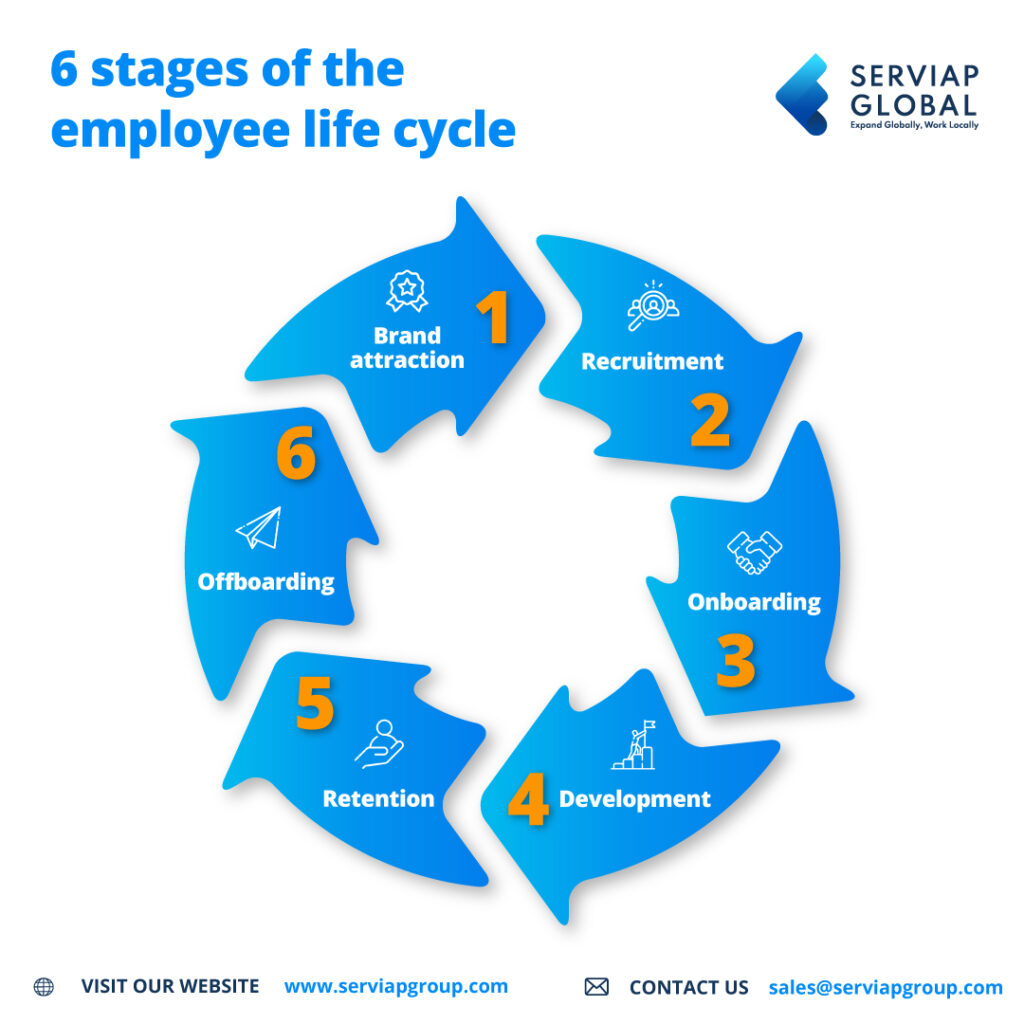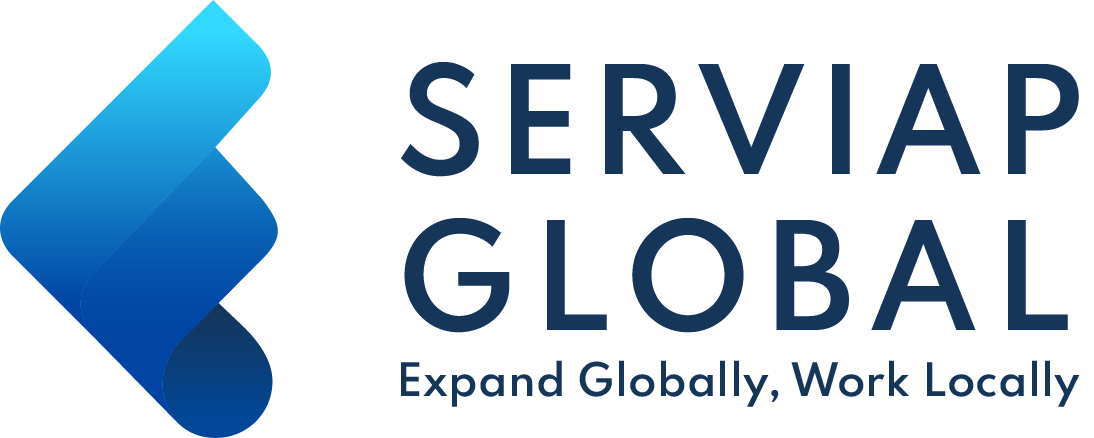Table of Contents
Everything that begins will eventually end and working for an organization is no exception. Because of this, modern HR departments use models to identify and optimize the different stages of an employee life cycle. All the steps matter, from first contact with the company to the day they leave and even after their departure.
Inspired by customer journey mapping, the employee life cycle represents a professional’s career path within a single company. Understanding the stages of this journey helps both individuals and the wider company to maximize productivity and fully develop skills.
Carefully managing each employee life cycle is fundamental to making the most of a company’s human capital. Below are the stages of this process and their importance.
At Serviap Global, we can help you manage the entire employee life cycle for international professionals in over 100 countries worldwide, including taking care of their payroll and other administrative matters, as part of our employer of record services.
SEE ALSO: Hire the best talent fast via an employer of record in Indonesia
If you would like international team members in place in a matter of weeks, if not days, contact us today.
Why is it important to understand the employee life cycle?
An employee’s experience within an organization can be every bit as valuable as that of a customer when it comes to developing the business.
Skillfully managing an employee life cycle allows all team members to mazimise their potential and fully develop their skills. Not only is that good for them, but it helps your company too.
The more information a business has about the paths its professionals take, the more the HR department can design career plans to motivate and reward workers according to their professional life stage.
If a company responds appropriately to the needs of its employees, they will feel recognized and valued, which translates into a better workplace environment for all. Five stages of the employee life cycle happen while they are with the company, plus one either side of joining and leaving.
The 6 stages of the employee life cycle
1) Brand attraction
The relationship between an employer and an employee starts from the first sight of the company’s brand and not from signing the employment contract. So the employee life cycle starts here.
When people first notice a brand and like it, they may consider working for it in the future. That is why firms need to project the right image, properly promoting their mission, vision, and values.
SEE ALSO: 4 workplace trends in 2023 that you won’t be able to miss
First impressions count, so a good picture of a business is essential to attract the best talent.
In today’s job market, people think not only about financial concerns but also the ethics of a company, their equality and diversity policies, mental health care, and work-life balance.
2) Recruitment stage in the employee life cycle
The first formal stage in the life cycle of an employee is recruitment, which begins with the job posting, followed by the application and selection process. Finally, it ends with signing an employment contract between the employee and the employer.
The employer should be thinking about a career plan right from the start of an employee’s time with the company. Having an idea of the employee life cycle at this stage will affect what you are looking for in a candidate.
The application process must give the candidate all the information necessary to know if the position is right for them. This helps self-selection and weeds out candidates that may not enjoy the role.
After reviewing the applicants, the right candidate must be selected within a reasonable period. This selection process should consider the eventual path you think the candidate may take within the company after recruitment, not just their current skills and abilities.
3) Onboarding
After signing the contract, the onboarding of the new employee starts. At this stage, the newcomer is excited about their new job and has a sense of optimism and potential. The employer, in turn, must make the new talent feel welcome and secure.
This part of the employee life cycle seeks to help newcomers integrate into the corporate culture and become part of a team. Therefore, it is necessary to reinforce the company’s values, mission, and vision, in addition to the role of the new employee in the organization.
For some organizations the onboarding process is short, for others this process may involve a series of activities spanning a month or more. An orientation session to get to know the rest of the team is vital, while regular communication and feedback will help newcomers adapt quickly.
During onboarding, the organization should provide the new professionals with all the tools they need to perform their jobs, such as email and access to the company’s communication platforms. Little things such as a small gift on arrival can also help to make them feel welcome.

4) Retention stage in the employee life cycle
Finding the best talent is one thing, but it’s no good if you can’t then retain those team members. During this stage, effective employee retention strategies need to be implemented, including additional training, growth opportunities, and other support that increases their attachment to the business.
Compensation and rewards will help the employee feel valued by their organization. Otherwise, they will begin looking for other job opportunities to help them achieve their goals.
For employees to stay, you should provide a welcoming culture and space to work in. Especially in the wake of the pandemic, technology used in the workplace is critical. According to a 2022 Harvard Business Review study, “how employees communicate, collaborate and connect [thanks to technology] are fundamental qualities of the employee experience.”
Retaining professionals does not just mean cultivating a strong company culture but also listening to individual team members. That helps the employer to know how they feel, what they are looking for, and what they expect from the organization, while also keeping them happy.
5) Development – the most crucial stage of the employee life cycle
Employee development and retention are closely related. Therefore, the organization should encourage the development of its staff through a career plan or incentives that support training, offer opportunities for promotion, and prevent them from looking for another job.
At this stage, it is essential to understand the strengths of a new professional, how they can improve their skills, and also how they can acquire others that will help them perform their activities better. All these answers will help tap into their potential over the employee life cycle.
An employer can use several strategies to encourage professional development. Mentoring sessions with more experienced colleagues encourage people to learn more and give a model for development, while subsidizing training courses outside the organization will help them grow professionally and personally.
Finally, companies must work on leadership at this stage because those who are trained today will be more ready tomorrow to take on greater responsibilities within the organization. Having a development plan and promotion opportunities for all team members will help to keep the best talent within the organization.
6) Last formal stage in the employee life cycle: offboarding
The end of an employee life cycle is an inevitability, but it doesn’t have to be a negative. Eventually, an employee will leave the company they have worked for, and whatever the reason for leaving, must be professional and on good terms.
Exit interviews help to evaluate the reasons for the termination of the relationship between the employee and the employer, as well as to obtain information on where not only the HR department but the entire organization can improve.
An employee’s departure also means making termination arrangements and thanking the now ex-employee for the services rendered. The company must take measures, such as a succession or transition plan.
The last stage in an employee life cycle affects those who leave and stay. For this reason, and to avoid uncertainty in the rest of the work team, it is necessary to communicate why the employee is leaving and whether someone else will take over their responsibilities while a new candidate is found.
An extra stage in the employee life cycle: creating ambassadors
Maintaining a good working relationship with employees throughout their lifecycle within an organization is essential to them being productive while they remain with the company.
It can also be a critical part of the employee life cycle of future team members, because someone who leave the organization on good terms and satusfied with their experience will become an ambassador for the company.
Such ex-employees will speak highly of the company, recommend it to others, and may even consider returning later. Those with bad experiences, on the other hand, could promote a negative image, and no mater how unjustified that may be, this can still be detrimental to the company.
In order not to damage the image of the business and to have happy leavers, some companies keep in touch with their former employees through social networks, by email, including using them as external consultants, or even reaching out to them when there is a vacancy to see if they know of any candidates.
Serviap Global can help you find and hire top talent overseas
Serviap Global is able to assist clients with international PEO / EOR services in over 100 countries worldwide. That means, we can hire overseas professionals on behalf of the client, handling their payroll and administration in the process.
We also offer global talent acquisition services to help you find talent to hire directly.
We are a family-run business that started out in Mexico more than 12 years ago, before expanding throughout the world. While our vision is global, we are committed to the sort of service excellence and individualised treatment that comes with working with a local provider.
Contact us today to find out more about how we can assist you with global hiring.
If you were interested in this article about the employee life cycle, check out more of our coverage here. Or read more about us.




